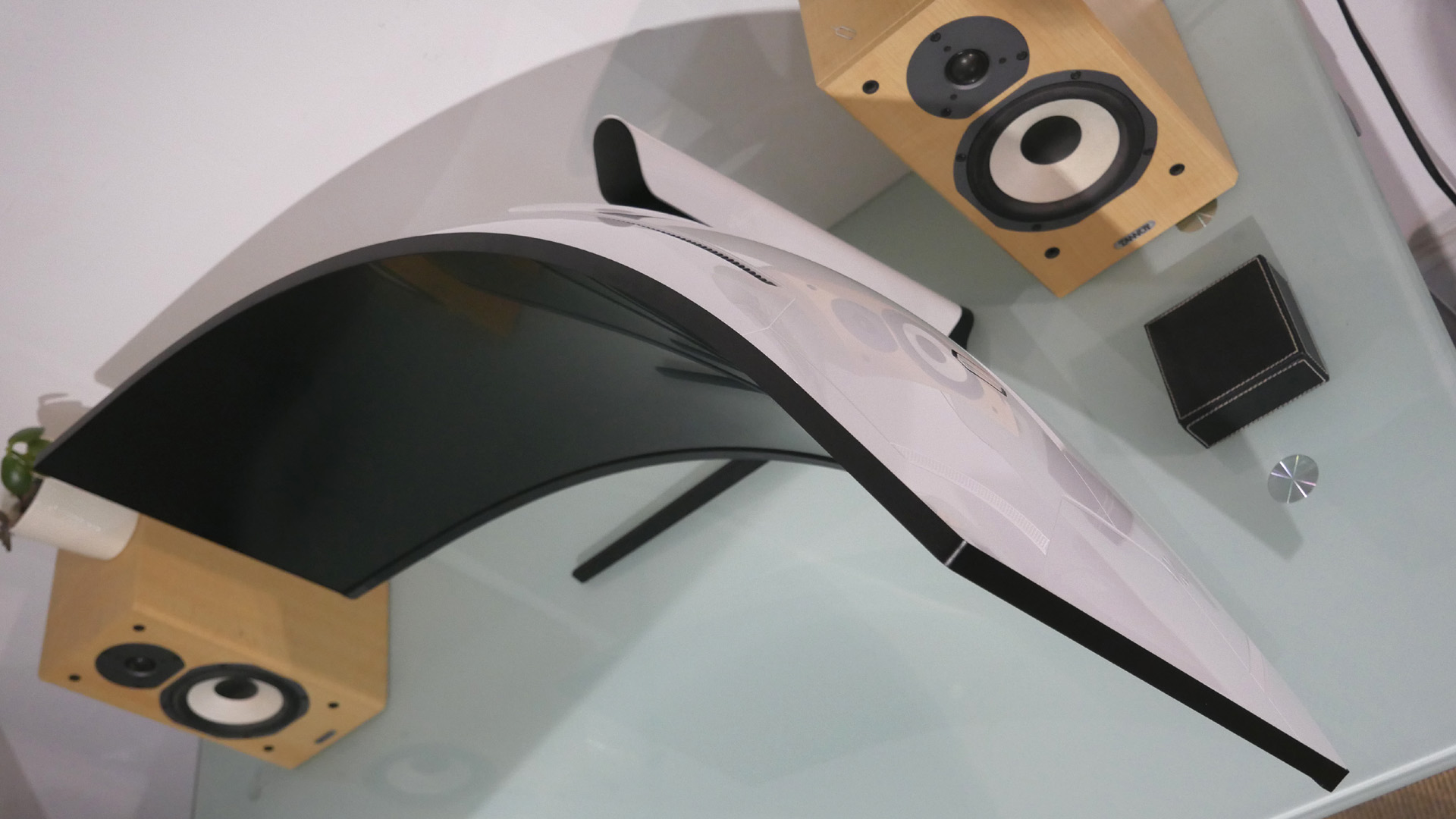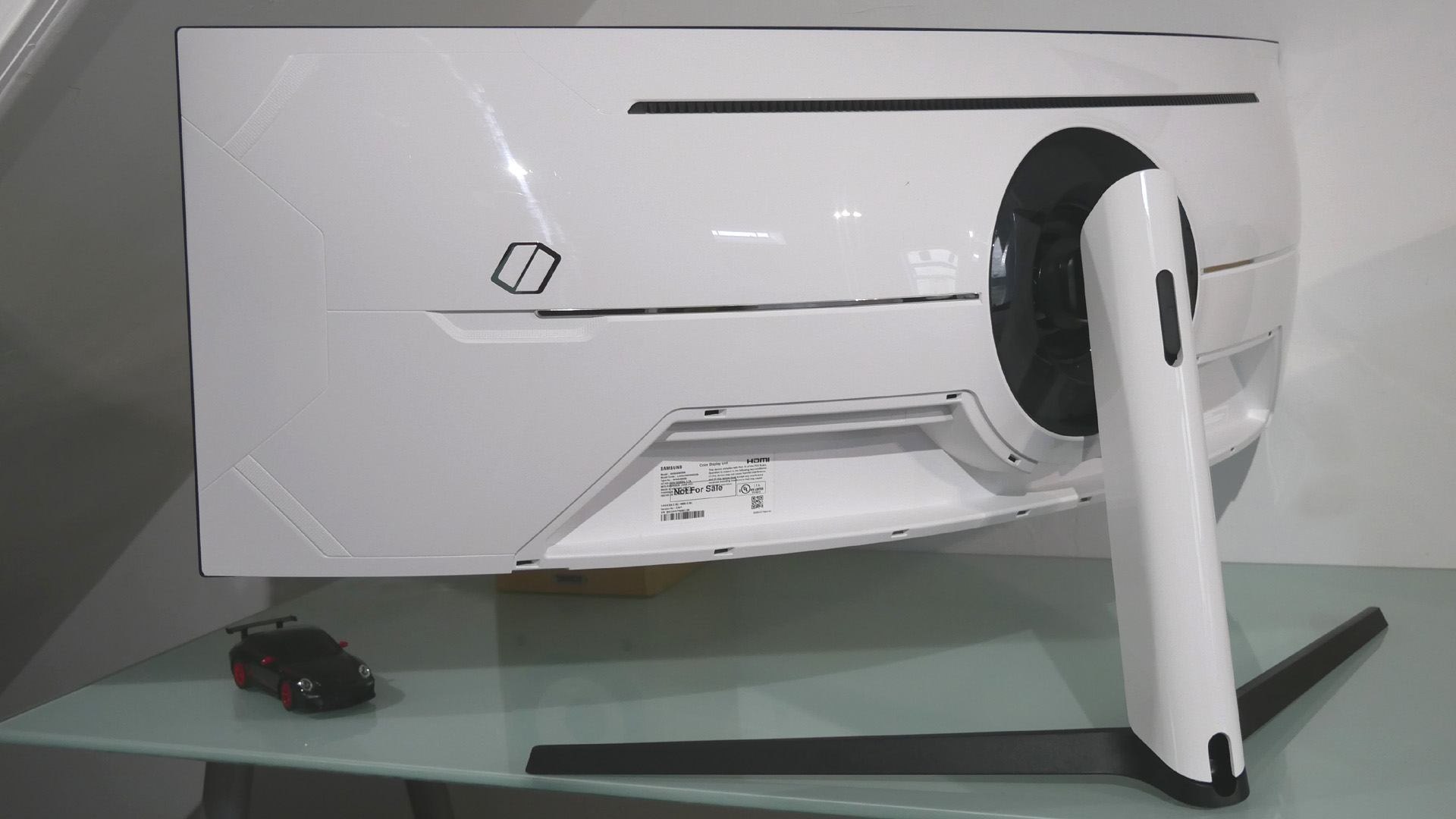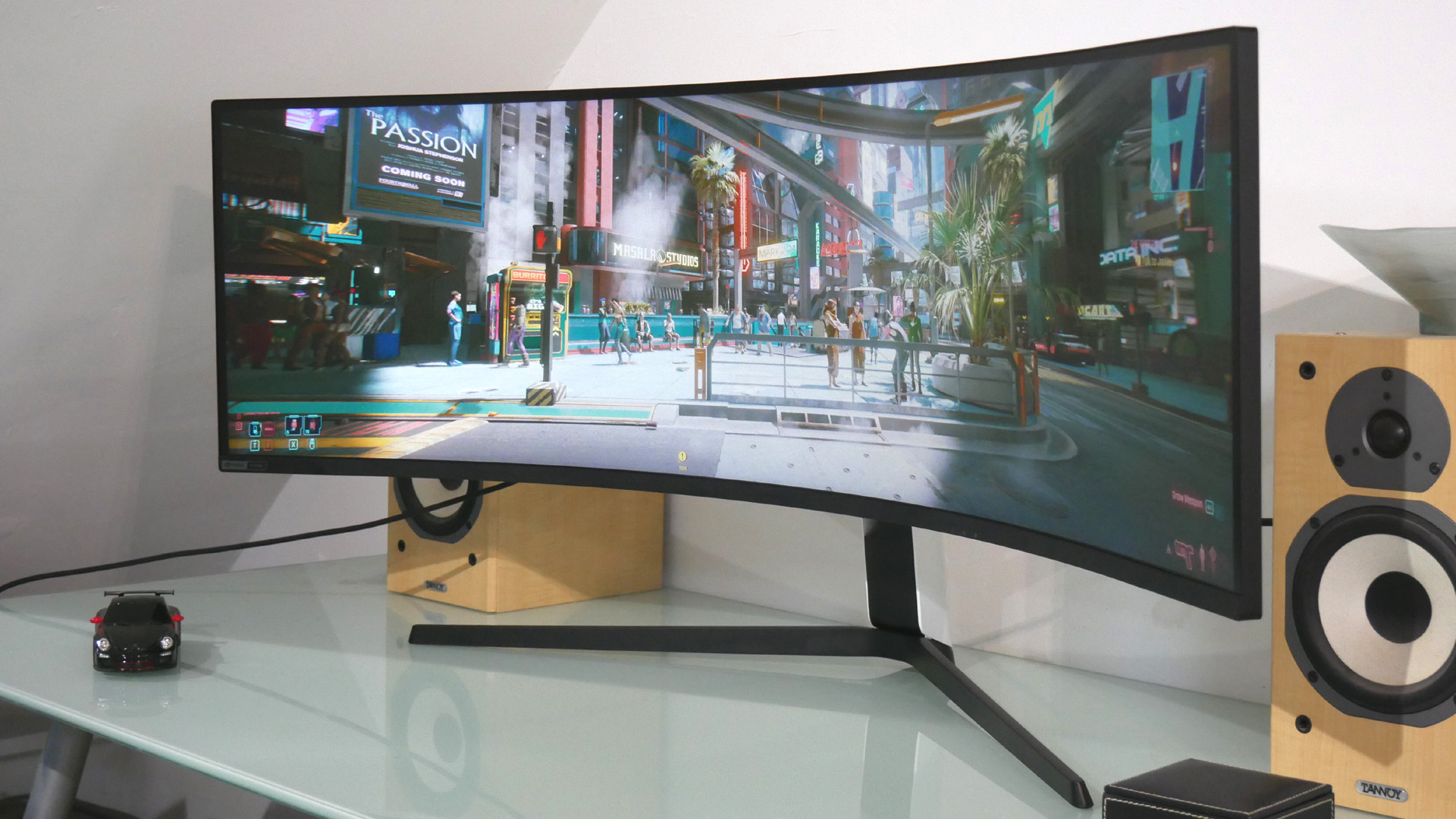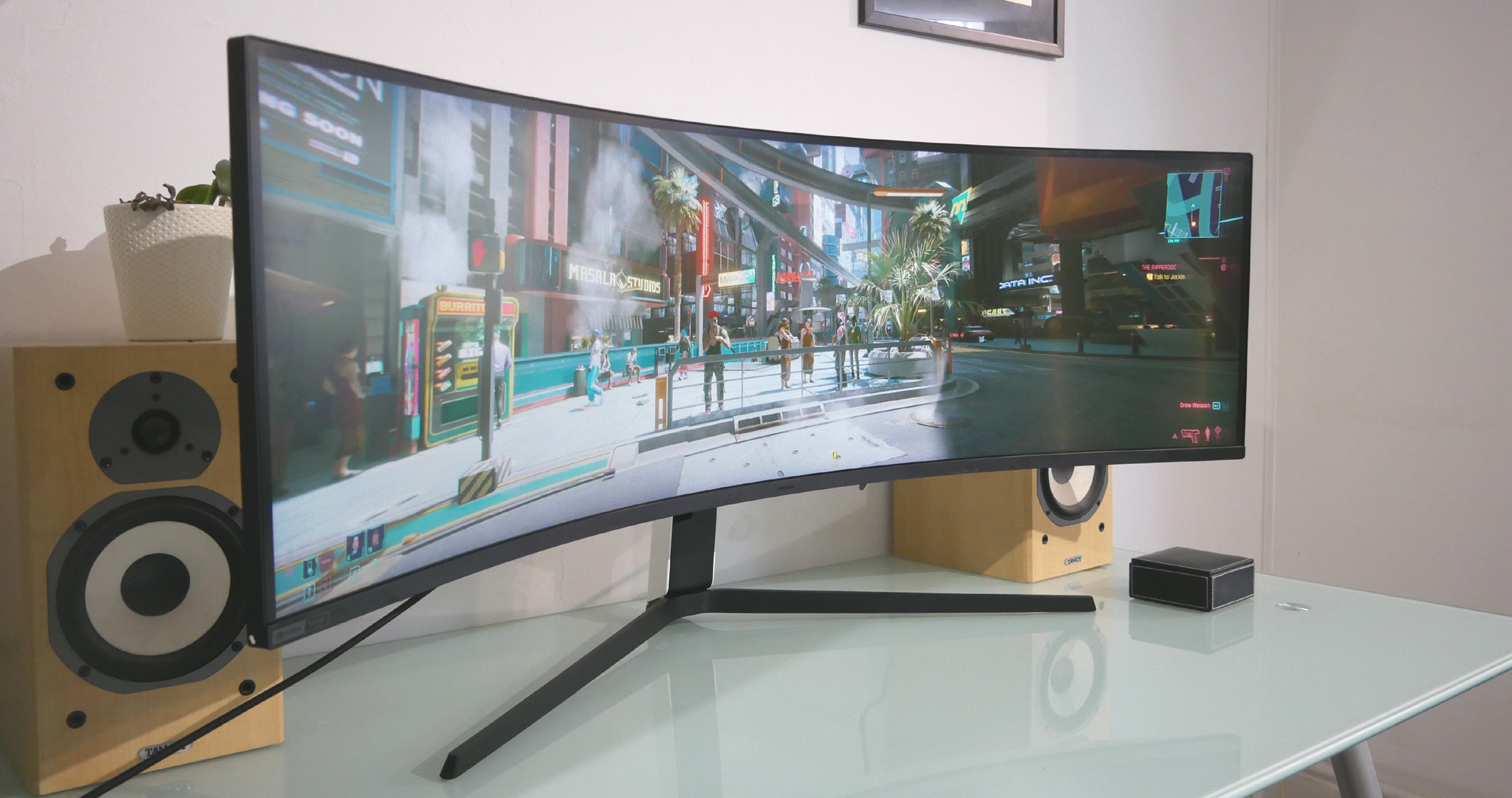GamesRadar+ Verdict
A spectacular gaming monitor, but not quite the technical tour de force we wanted
Pros
- +
Stupendously immersive gaming experience
- +
Stupidly bright and punchy
- +
Fantastic response and speed
Cons
- -
Mini-LED backlight is surprisingly crude
- -
Pixel density is nothing special
- -
Insanely expensive
Why you can trust GamesRadar+
Samsung’s epic G9 is back. The new Samsung Odyssey Neo G9 takes the familiar but still outrageous recipe of a 49-inch, uber-curved, and ultra-fast gaming monitor and garnishes it with cutting-edge backlighting technology plus HDMI 2.1 connectivity to make a charge on 2021's best gaming monitor and best curved gaming monitor lists. Spicy.
Of course, display technology on this epic scale is going to cost you, and this thing is painfully pricey. But then the huge VA panel does run at 240Hz, achieve a claimed 1ms response, and hit a slightly silly 2,000 nits peak brightness. And then there’s that new backlight. That’s where the real showbiz magic happens, on paper at least. It’s a mini-LED solution with no fewer than 2,048 local dimming zones.
The old Samsung G9 was a stunner in many ways, but with just 10 edge-lit dimming zones, it wasn’t the real HDR deal. The new ‘Neo’ model promises to fix that problem. And then some.
Design & Features
By several measures, the Samsung Odyssey Neo G9 looks just like its non-Neo progenitor. You get the same epic 49-inch proportions with extreme 1000R curvature (note that, as with the original G9, only the middle portion of the panel is actually curved, while the extremities on either side flatten out). The panel resolution is likewise carried over at 5,120 by 1,440 pixels, as is the 240Hz refresh, 1ms grey-to-grey pixel response, and 95 percent DCI-P3 colour coverage from the VA panel. Indeed, it’s likely the LCD panel itself is unchanged.

What has been upgraded is the backlight, from a relatively dumb edge-lit solution with 10 dimming zones to a full-array mini-LED backlight with 2,048 zones. The net result is not only a boost in claimed peak brightness from 1,000 nits to a scarcely comprehensible 2,000 nits but also the promise of something much closer to true HDR capability across the panel thanks to much more granular control of the backlight.
Another significant upgrade is the addition of HDMI 2.1 connectivity. That adds flexibility in a general sense and more specifically opens up the possibility of this being a genuinely viable PS5 monitor, PS4 monitor, or Xbox Series X monitor in the future, should Microsoft or Sony see fit to support the Neo G9’s ultrawide 32:9 pixel grid. Even if that does happen, however, you won’t see the full 240Hz refresh with any console. That will remain a feature that only the best gaming PCs or best gaming laptops can take advantage of.
Elsewhere, the industrial design is a dead ringer for the original G9. So that’s upscale plastics including a stormtrooper vibe to the main enclosure of the LCD panel, plus CoreSync LED mood lighting. As before, when it comes to audio there are no integrated speakers, just a headphone port.

Performance
Like the first G9, the Neo G9 puts on a serious show. The sheer scale and extreme curvature makes for a level of immersion that few, if any, other displays can rival. As before, the 5,120 by 1,440 pixel grid translates into moderate pixel density for general computing. At this lofty price point, there are better options for multi-tasking. There are arguably also better screens for watching video, too, given most TV and streaming content is formatted to the narrower 16:9 aspect, leaving much of the huge 49-inch 32:9 panel with nothing to display.
In other words, this screen is all about gaming. So, does it deliver? Yes. And no. The good news is that, at its best, this monitor absolutely socks it to you. Where supported, games running in HDR really sizzle. Cyberpunk 2077 is arguably the king of HDR eye candy right now, and it’s never looked more enthralling. This panel’s ability to show retina-searing sunlight and inky black shadows in the same scene at the same time is a genuine thrill.
Pixel performance and latency are further strong points. Nobody does fast VA panels like Samsung and the Neo G9 is no exception. Call it an esoteric observation, but the clarity of text when you’re scrolling a webpage, aided by the 240Hz refresh, is really something. In game, it’s about as good as an LCD monitor gets.

So, what’s the catch? The new mini-LED backlight isn’t quite the revelation we’d hoped for. Yes, it does allow for better control of the backlighting. But in a PC context, there is some surprising clunkiness in its detailed implementation. When navigating the Windows desktop, it’s all too easy to see differences in the backlighting power, both dynamically when moving objects like cursors and whole application windows, and statically across certain rendered elements, like a dialogue box sitting across the divide between bright and dark background features.
At its worst, it can be very ugly and distracting. From a pure productivity panel perspective, it would be unacceptable at any price point, let alone on a screen this expensive. In-game, it’s much harder to detect these issues. But what the desktop experience shows is that, even with 2,048 dimming zones, the detailed control of the backlight is still pretty crude.

Overall - should you buy it?
It's fabulous but a little flawed, but in purely rational and value terms, the new Samsung Odyssey Neo G9 doesn’t make sense. It’s nearly double the price of its already pricey predecessor and by most measures, it doesn’t move the game on. You don’t get any more pixels, there’s no more speed, the design is the same and the only additional peripheral feature is HDMI 2.1, which isn’t actually of huge benefit right now.
So, it all comes down to that cutting-edge mini-LED backlight. On that, we have mixed feelings. On the one hand, it’s hard not to be disappointed by how crude it turns out to be on close objective inspection. On the other, the subjective experience in games, which is what really counts, is pretty darn stellar. The Neo G9 isn’t quite the tour de force we were expecting. It’s hard to recommend as a real-world purchase. But if you’ve got the money and what you really want is the most dramatic PC-powered experience on the planet, well, it’s hard to think of anything better. For console gamers, a 120Hz 4K TV or one of LG's contenders for best OLED TVs, like the LG C1 or CX, is surely a better bet and cheaper to boot.
Looking for a machine to team with your new monitor? Check out the best gaming laptops and best gaming PCs.
A serious dissertation on the finer points of input lag and overshoot followed by a forensic examination of AI-accelerated temporal upscaling. Such is a routine day in the working life of long-time tech wordsmith, Jeremy Laird. Along with GamesRadar, Jeremy’s 15-year back catalogue includes a host of tech and gaming outlets, including TechRadar and PC Gamer, not to mention contributions to mainstream media from the Independent to the Evening Standard. Complimenting Jeremy’s debilitating addiction to all kinds of digital hardware, he is also afflicted by an obsession with and a significant occupational sideline in cars and automotive technology.





